Two days ago I posted a review of a new GPS unit, and yesterday I posted some photos of a soaking wet bird that I took during a storm. Little did I know at the time, but those posts were destined to become related.
It seems that the large tree shown at the left in this picture on the GPS-related post was blown down by the storm of the wet-bird post:
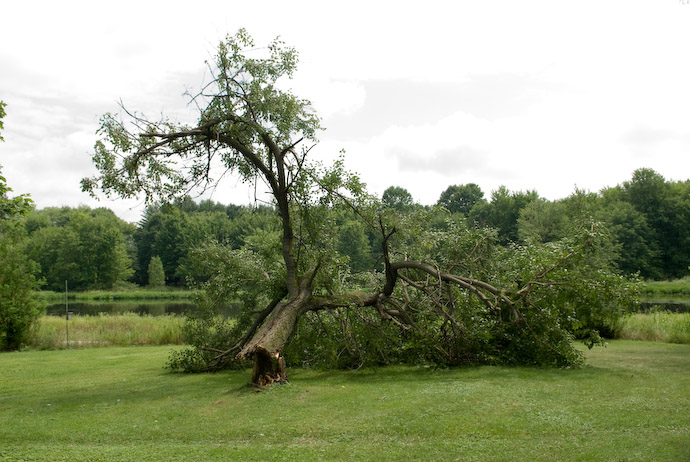
Nikon D200 + Nikkor 17-55 f/2.8 @ 19mm — 1/320 sec, f/7.1, ISO 250 — map & image data — nearby photos
Oops
The tree was an old, crotchety mulberry tree that had seen better days. When I was a kid, it was glorious, both fun to climb and producing a lot of mulberries that I'd use to give myself a bellyache every summer.
It was sad to see it down, but it needed to be cleared up, so Dad went to do it, and I hung around and took pictures (yet, magnanimously, occasionally interrupting to offer unsolicited advice).
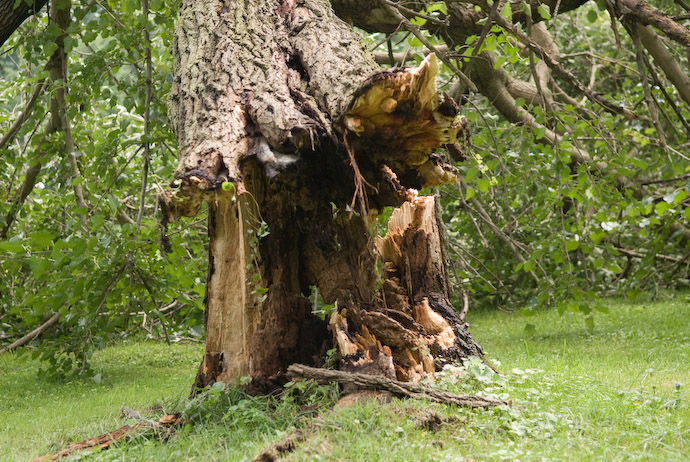
Nikon D200 + Nikkor 17-55 f/2.8 @ 45mm — 1/400 sec, f/3.5, ISO 250 — map & image data — nearby photos
Broke Off at the Base
Dad cut off a huge branch, chained it to the trusty old backhoe he's had for 30 years, and dragged it off into the woods.
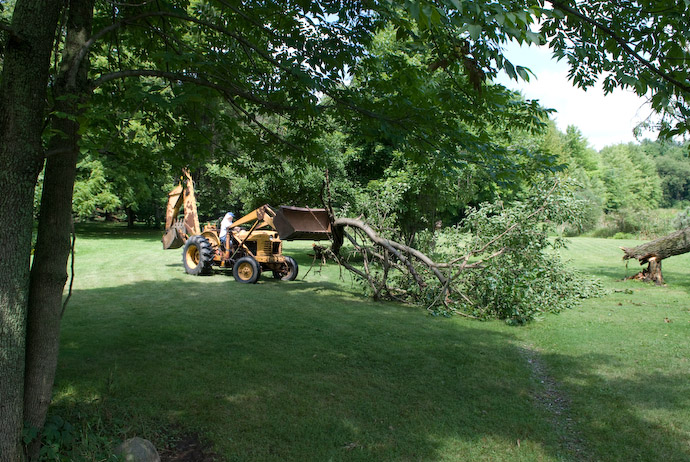
Nikon D200 + Nikkor 17-55 f/2.8 @ 17mm — 1/160 sec, f/7.1, ISO 200 — map & image data — nearby photos
Branch #1 Heads to the Woods
Half way there, the branch started digging into the ground, so we heaved and ho'ed until we rolled it over to its more leafy side, and then he continued dragging it toward the woods. (The branch and backhoe are in the background in the center of the picture below.)
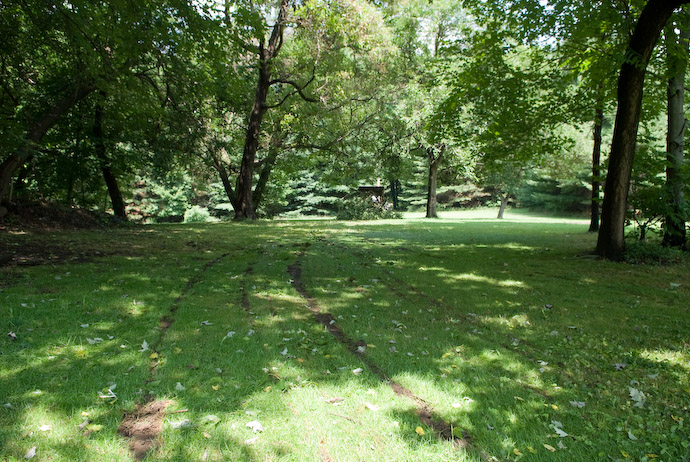
Nikon D200 + Nikkor 17-55 f/2.8 @ 17mm — 1/200 sec, f/4.5, ISO 200 — map & image data — nearby photos
Lawn Scars
Once in the woods, the branch was unhooked from the backhoe and he shoved it out of the way.
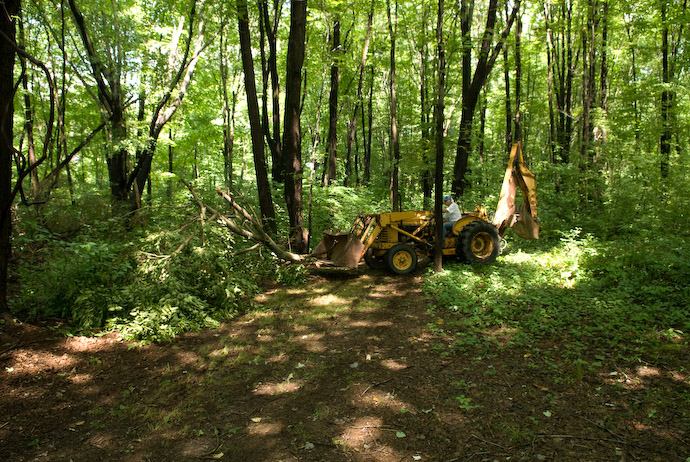
Nikon D200 + Nikkor 17-55 f/2.8 @ 17mm — 1/80 sec, f/4.5, ISO 400 — map & image data — nearby photos
Shoving the Branch Out of the Way
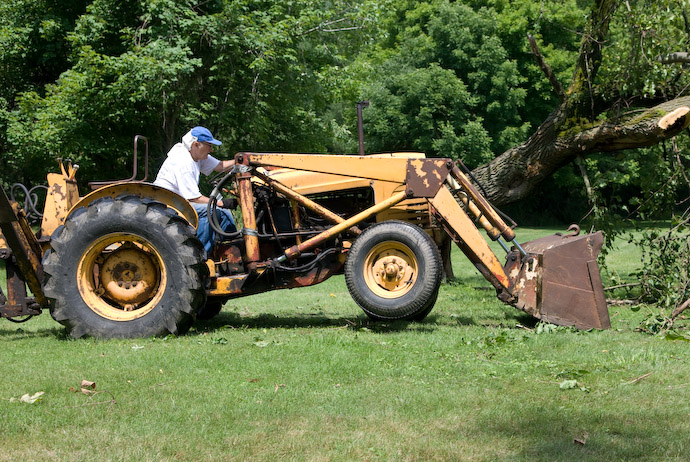
Nikon D200 + Nikkor 17-55 f/2.8 @ 30mm — 1/2000 sec, f/4.5, ISO 400 — map & image data — nearby photos
One Way to Turn
One way to turn the front wheels of the backhoe sharply without ripping up the grass or placing undue stress on the steering mechanism is to simply push the front bucket down far enough that it lifts the front tires off the ground.
Returning to the tree, he used the backhoe to shove the tree the rest of the way off the stump, rolling it over so that another big branch would be safer to cut off.
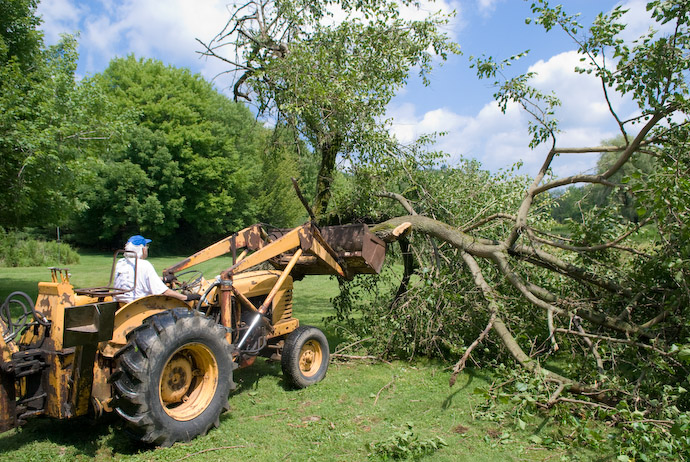
Nikon D200 + Nikkor 17-55 f/2.8 @ 17mm — 1/2000 sec, f/4.5, ISO 400 — map & image data — nearby photos
Shoving the Tree Over
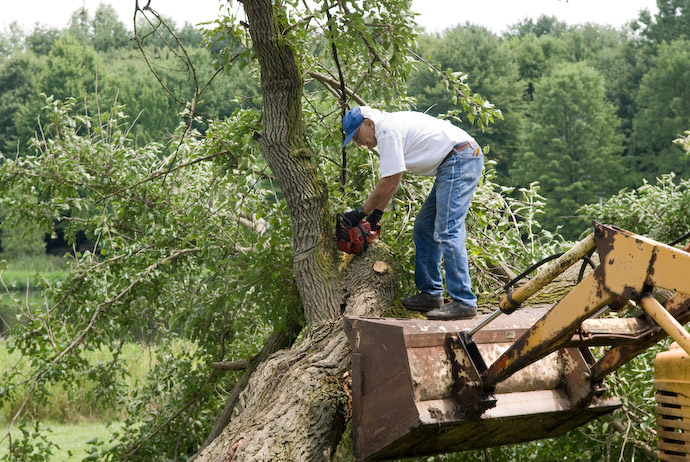
Nikon D200 + Nikkor 17-55 f/2.8 @ 55mm — 1/180 sec, f/6.3, ISO 250 — map & image data — nearby photos
Cutting a Foot-Thick Branch
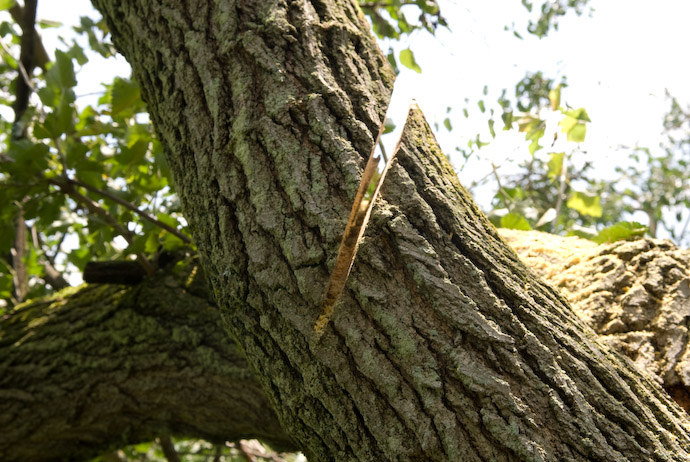
Nikon D200 + Nikkor 17-55 f/2.8 @ 30mm — 1/200 sec, f/8, ISO 250 — map & image data — nearby photos
The Cut
The cut is only about half way through, but a huge amount of wood is on the branch above the cut, leaning out with leverage placing a massive amount of pressure on the wood that remains. He then just shoved the tree with the backhoe, and the huge branch came crashing down. (The photo below is mid-crash.)
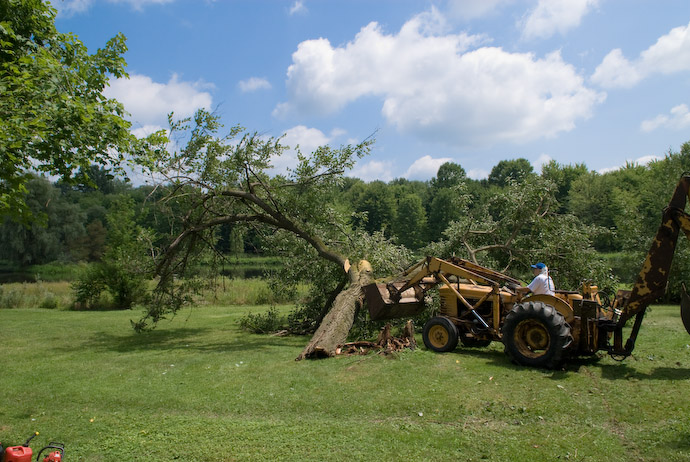
Nikon D200 + Nikkor 17-55 f/2.8 @ 17mm — 1/500 sec, f/8, ISO 250 — map & image data — nearby photos
Down Comes the Huge Branch
Doing it this way is much safer than cutting all the way through, since it allows you to be well away from the tree when the big branch comes down. I guess Dad learned a thing or two growing up on a farm.
The branch was dragged to the woods, and he returned to work on the main trunk.
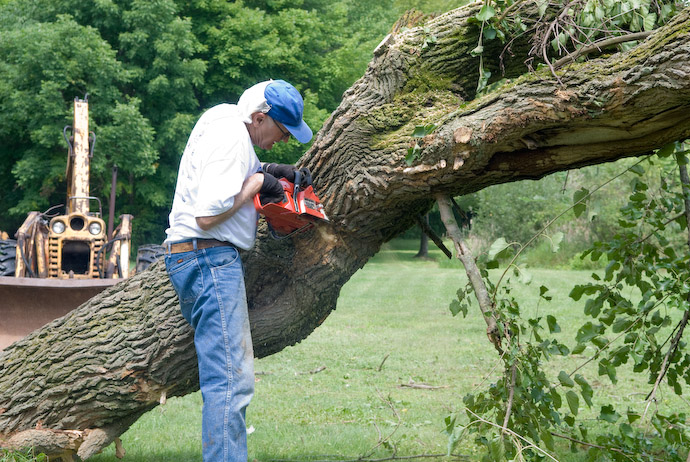
Nikon D200 + Nikkor 17-55 f/2.8 @ 40mm — 1/125 sec, f/6.3, ISO 250 — map & image data — nearby photos
Notching the Main Trunk
After notching it from above and below, and from one side, leaving the trunk connected to the upper branches by only a small cross-section of wood, he pressed on the joint with the backhoe to complete the break. That didn't work, so he tried lifting one end, hoping to snap it where it was notched...
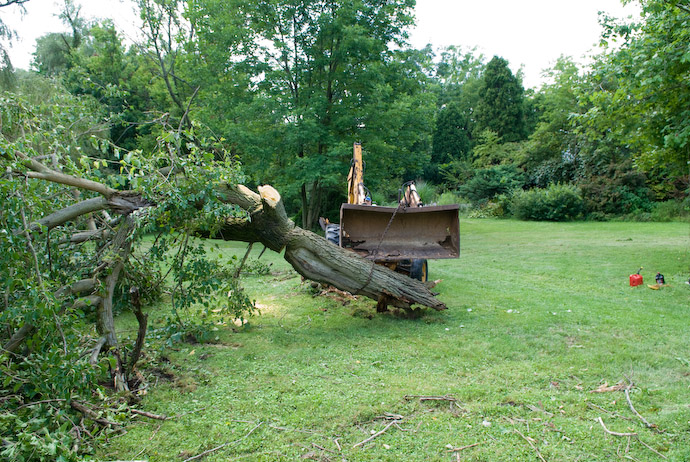
Nikon D200 + Nikkor 17-55 f/2.8 @ 17mm — 1/80 sec, f/6.3, ISO 250 — map & image data — nearby photos
Trying To Snap The Main Trunk
That didn't work either, so he put that task aside and cut off another huge branch. During that cut, the chainsaw got stuck in the cut, so we had to pound a wedge (four of them, actually) into the cut to release the pinching pressure enough to extract the chain saw.
Half an hour wasted with the stuck chainsaw behind us, he dragged that branch to the woods.
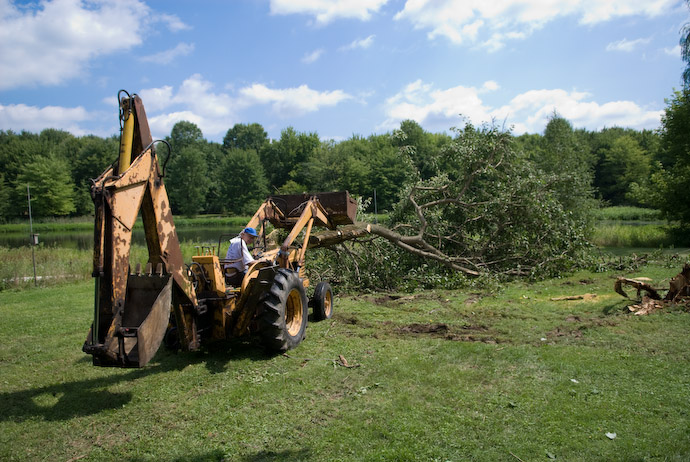
Nikon D200 + Nikkor 17-55 f/2.8 @ 17mm — 1/3000 sec, f/2.8, ISO 250 — map & image data — nearby photos
Huge Branch #3 Heads to the Woods
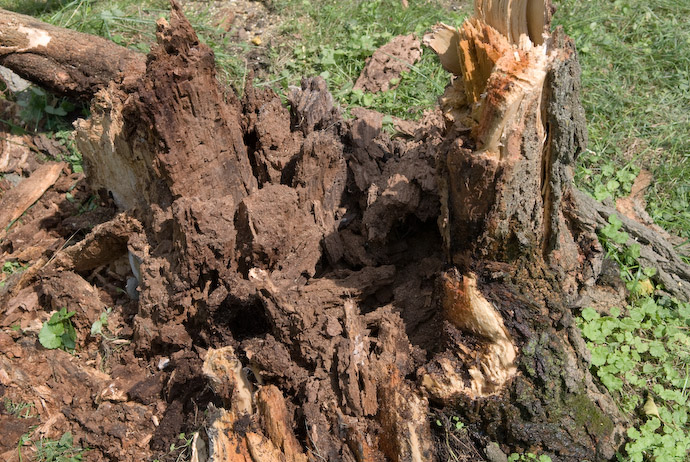
Nikon D200 + Nikkor 17-55 f/2.8 @ 34mm — 1/640 sec, f/6.3, ISO 250 — map & image data — nearby photos
The Stump
The very base of the tree consisted of a ring of healthy wood surrounding a core of what might best be described as a mix between swiss cheese and cork. It had the load-bearing properties of wet tissue.
Back from the woods, he used the backhoe to again roll the remains of the tree such that the trunk was safe to cut through completely, and he headed off to the woods with it.
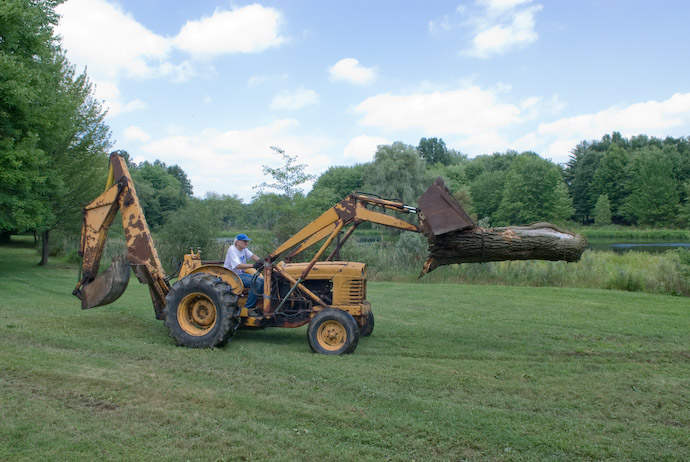
Nikon D200 + Nikkor 17-55 f/2.8 @ 17mm — 1/160 sec, f/8, ISO 200 — map & image data — nearby photos
The (Extremely Heavy) Trunk Heads to the Woods
It's on days like today that the backhoe is worth its weight in gold.
He then chains the entire rest of the tree to the backhoe, lifts, and heads to the woods for a fifth time.
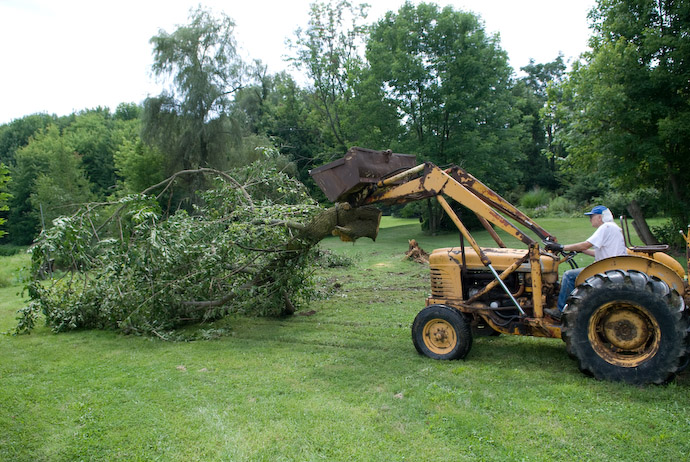
Nikon D200 + Nikkor 17-55 f/2.8 @ 17mm — 1/320 sec, f/4.5, ISO 100 — map & image data — nearby photos
Hauling the Rest of the Tree to the Woods
Following a sixth trip to the woods with the backhoe's front loader filled with the remaining assorted branches and twigs, we're done for now; He'll do something with the stump another day.
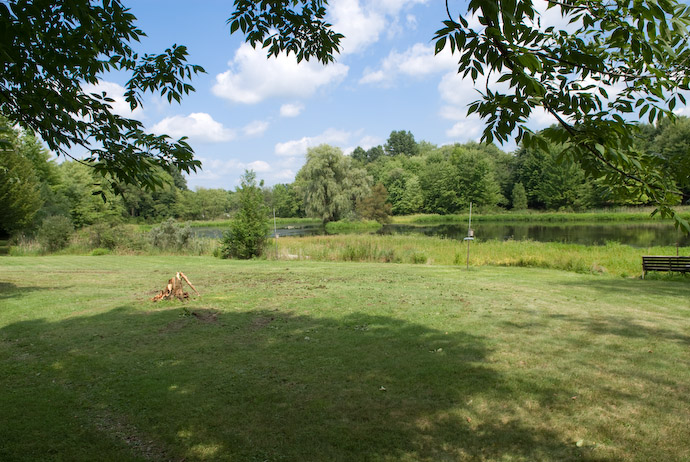
Nikon D200 + Nikkor 17-55 f/2.8 @ 17mm — 1/160 sec, f/7.1, ISO 100 — map & image data — nearby photos
A More “Wide Open View” Than Before
After unsticking the chain saw that one time, the cut still had a couple of wedges in it, so Dad couldn't use the chainsaw to finish the cut. He used the backhoe to essentially rip the branch from the tree, at which point neither of us thought to pick up the wedges. I remembered them later, and spent five unsuccessful minutes looking for them before spending another minute to grab our metal detectors, with which we found them in about 30 seconds.
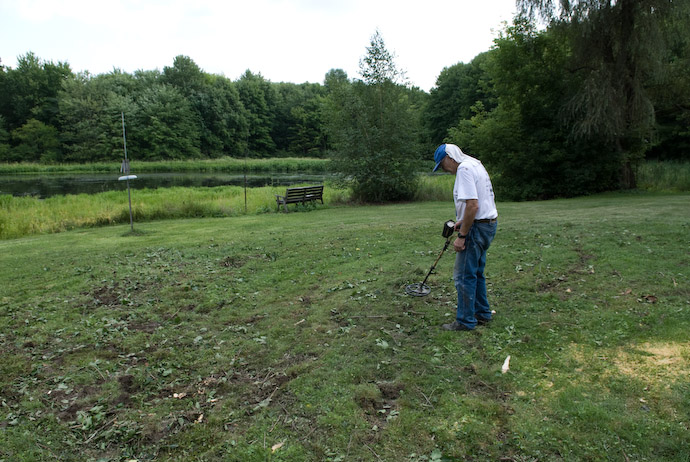
Nikon D200 + Nikkor 17-55 f/2.8 @ 17mm — 1/90 sec, f/7.1, ISO 100 — map & image data — nearby photos
Hunting for the Wedges
All in all, it took Nature a lot of years (100?) to grow the tree, a storm a few seconds to bring it down, and Dad about two hours and fifteen minutes to clear it away (which includes 30 minutes futzing with the stuck chainsaw). I shudder to think how long it would have taken to clear it without the backhoe, or even worse, without a chainsaw either.
It certainly pays to have the right tools for the job.
Sad end to the tree, but a nice lesson in tree removal.
I believe that mulberries root quite readily from hardwood cuttings taken in summer – some even talk of 8ft (!) long branches taking root, but the norm would I think be to use strong 2-year old shoots about 8 inches long, put in the ground in light shade, with about 5-6 inches below ground. Might be worth putting a few cuttings in, then you could give the tree another 100 years or so ;o)
Peter
Awwwww, that’s sad that great old tree is gone. But I guess there’ll be plenty of firewood next winter.
Looks like a great place for children. Lake, trees, grass…
Dan
I must admit, I’d probably leave the damn tree on the ground. That’s probably the difference between your dad and me.